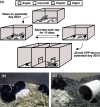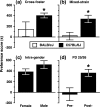Social reward among juvenile mice
- PMID: 17212648
- PMCID: PMC2040181
- DOI: 10.1111/j.1601-183X.2006.00295.x
Social reward among juvenile mice
Abstract
Mammalian social relationships, such as mother-offspring attachments and pair bonds, can directly affect reproductive output. However, conspecifics approach one another in a comparatively broad range of contexts, so conceivably there are motivations for social congregation other than those underlying reproduction, parental care or territoriality. Here, we show that reward mediated by social contact is a fundamental aspect of juvenile mouse sociality. Employing a novel social conditioned place preference (SCPP) procedure, we demonstrate that social proximity is rewarding for juvenile mice from three inbred strains (A/J, C57BL/6J and DBA/2J), while mice from a fourth strain (BALB/cJ) are much less responsive to social contact. Importantly, this strain-dependent difference was not related to phenotypic variability in exploratory behavior or contextual learning nor influenced by the genetic background associated with maternal care or social conditioning. Furthermore, the SCPP phenotype was expressed early in development (postnatal day 25) and did not require a specific sex composition within the conditioning group. Finally, SCPP responses resulted from an interaction between two specifiable processes: one component of the interaction facilitated approach toward environments that were associated with social salience, whereas a second component mediated avoidance of environmental cues that predicted social isolation. We have thus identified a genetically prescribed process that can attribute value onto conditions predicting a general form of social contact. To our knowledge, this is the first definitive evidence to show that genetic variation can influence a form of social valuation not directly related to a reproductive behavior.
Figures





References
-
- Agmo A, Gomez M. Sexual reinforcement is blocked by infusion of naloxone into the medial preoptic area. Behav Neurosci. 1993;107:812–818. - PubMed
-
- Bardo MT, Bevins RA. Conditioned place preference: what does it add to our preclinical understanding of drug reward? Psychopharmacology (Berl) 2000;153:31–43. - PubMed
-
- Berridge KC, Robinson TE. What is the role of dopamine in reward: hedonic impact, reward learning, or incentive salience? Brain Res Brain Res Rev. 1998;28:309–369. - PubMed
-
- Berridge KC, Robinson TE. Parsing reward. Trends Neurosci. 2003;26:507–513. - PubMed
-
- Berton O, McClung CA, Dileone RJ, Krishnan V, Renthal W, Russo SJ, Graham D, Tsankova NM, Bolanos CA, Rios M, Monteggia LM, Self DW, Nestler EJ. Essential role of BDNF in the mesolimbic dopamine pathway in social defeat stress. Science. 2006;311:864–868. - PubMed
Publication types
MeSH terms
Grants and funding
LinkOut - more resources
Full Text Sources
Molecular Biology Databases

